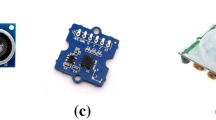Abstract
This paper proposes a mobile application named “Sightless Helper”, for assisting blind or visually impaired people. The application uses footstep counting and GPS for indoor and outdoor navigation. It can detect objects and unsafe areas to ensure safe navigation. The system consists of voice recognition, touchpad, button and shaking sensor for easy interaction between the user and the system. During any kind of accident, it can detect unusual shaking of the user, and send his/her location to some emergency contacts. “Sightless Helper” pro-vides several useful additional features such as calendar, news reading, barcode reading, battery monitoring, etc. The performance of the application is tested considering voice recognition time and location sending time. The experimental result shows that the voice recognition time of the application is around 6.303 ms and 6.375 ms for male and female voices respectively. The average location sending time is nearly 7.629 ms to any distance. The usability test result reveals that the proposed application has an average 72.2% System Usability Scale (SUS) score, showing its suitability for practical implementation.
Access this chapter
Tax calculation will be finalised at checkout
Purchases are for personal use only
Similar content being viewed by others
References
Visual impairment and blindness 2010, August 2016. http://www.who.int/blind-ness/data_maps/VIFACTSHEETGLODAT2010full.pdf
Hersh, M., Johnson, M.A.: Assistive Technology for Visually Impaired and Blind People. Springer, London (2010). https://doi.org/10.1007/978-1-84628-867-8
Hub, A., Diepstraten, J., Ertl, T.: Design and development of an indoor navigation and object identification system for the blind. In: ACM SIGACCESS Accessibility and Computing, no. 77–78, pp. 147–152. ACM (2004)
Ahmetovic, D., Gleason, C., Kitani, K.M., Takagi, H., Asakawa, C.: NavCog: turn-by-turn smartphone navigation assistant for people with visual impairments or blindness. In: Proceedings of the 13th Web for All Conference, p. 9. ACM (2016)
Ahmetovic, D., Gleason, C., Ruan, C., Kitani, K., Takagi, H., Asakawa, C.: NavCog: a navigational cognitive assistant for the blind. In: Proceedings of the 18th International Conference on Human-Computer Interaction with Mobile Devices and Services, pp. 90–99. ACM (2016)
AlAbri, H.A., AlWesti, A.M., AlMaawali, M.A., AlShidhani, A.A.: NavEye: smart guide for blind students. In: 2014 Systems and Information Engineering Design Symposium (SIEDS), pp. 141–146. IEEE (2014)
Vijayalakshmi, N., Kiruthika, K.: Voice based navigation system for the blind people. Int. J. Sci. Res. Comput. Sci. Eng. Inf. Technol. IJSRCSEIT 5, 256–259 (2019)
Blenkhorn, P., Evans, G., King, A., Kurniawan, S.H., Sutcliffe, A.: Screen magnifiers: evolution and evaluation. IEEE Comput. Graphics Appl. 23(5), 54–61 (2003)
Cruz, F., Yumang, A., Mañalac, J., Cañete, K., Milambiling, J.: Smart backpack for the blind with light sensors, ZigBee, RFid for grid-based selection. In: AIP Conference Proceedings, vol. 2045, p. 020054. AIP Publishing (2018)
El-Behiery, H., Abdel-Wahab, M.: Smart touch phones blind assistant system. Am. J. Syst. Softw. 2(3), 72–80 (2014)
Sabab, S.A., Ashmafee, M.H.: Blind reader: an intelligent assistant for blind. In: 2016 19th International Conference on Computer and Information Technology (ICCIT), pp. 229–234. IEEE (2016)
Sato, D., Oh, U., Naito, K., Takagi, H., Kitani, K., Asakawa, C.: Navcog3: an evaluation of a smartphone-based blind indoor navigation assistant with semantic features in a large-scale environment. In: Proceedings of the 19th International ACM SIGACCESS Conference on Computers and Accessibility, pp. 270–279. ACM (2017)
Ranjan, A., Navamani, T.M.: Android-based blind learning application. In: Hu, Y.-C., Tiwari, S., Mishra, K.K., Trivedi, M.C. (eds.) Ambient Communications and Computer Systems. AISC, vol. 904, pp. 247–255. Springer, Singapore (2019). https://doi.org/10.1007/978-981-13-5934-7_22
Tekin, E., Vásquez, D., Coughlan, J.M.: SK smartphone barcode reader for the blind. In: Journal on Technology and Persons with Disabilities: Annual International Technology and Persons with Disabilities Conference, vol. 28, p. 230. NIH Public Access (2013)
Olmschenk, G., Yang, C., Zhu, Z., Tong, H., Seiple, W.H.: Mobile crowd assisted navigation for the visually impaired. In: 2015 IEEE 12th International Conference on Ubiquitous Intelligence and Computing and 2015 IEEE 12th International Conference on Autonomic and Trusted Computing and 2015 IEEE 15th International Conference on Scalable Computing and Communications and Its Associated Workshops (UIC-ATC-ScalCom), pp. 324–327. IEEE
Tensor flow. https://www.tensorflow.org/lite. Accessed 24 Nov 2019
Android studio. https://developer.android.com/studio. Accessed 25 Nov 2019
Bangor, A., Kortum, P., Miller, J.: Determining what individual SUS scores mean: adding an adjective rating scale. J. Usability Stud. 4(3), 114–123 (2009)
Brooke, J., et al.: SUS-a quick and dirty usability scale. Usability Eval. Ind. 189(194), 4–7 (1996)
Author information
Authors and Affiliations
Corresponding author
Editor information
Editors and Affiliations
Rights and permissions
Copyright information
© 2020 ICST Institute for Computer Sciences, Social Informatics and Telecommunications Engineering
About this paper
Cite this paper
Hossain, M.E., Qaiduzzaman, K.M., Rahman, M. (2020). Sightless Helper: An Interactive Mobile Application for Blind Assistance and Safe Navigation. In: Bhuiyan, T., Rahman, M.M., Ali, M.A. (eds) Cyber Security and Computer Science. ICONCS 2020. Lecture Notes of the Institute for Computer Sciences, Social Informatics and Telecommunications Engineering, vol 325. Springer, Cham. https://doi.org/10.1007/978-3-030-52856-0_46
Download citation
DOI: https://doi.org/10.1007/978-3-030-52856-0_46
Published:
Publisher Name: Springer, Cham
Print ISBN: 978-3-030-52855-3
Online ISBN: 978-3-030-52856-0
eBook Packages: Computer ScienceComputer Science (R0)




